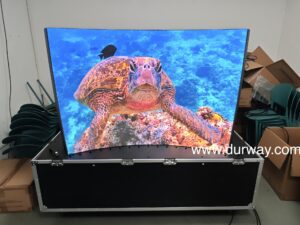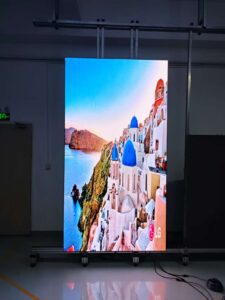Ford Driving Simulator: How It Works and Why It Matters for Training and R&D
A Ford driving simulator is a high-fidelity virtual driving environment built around a Ford vehicle platform and advanced simulation technology. Ford uses large-scale simulators like VIRTTEX and its multi-million-dollar dynamic driving simulator in Dearborn to test new vehicles, driver-assistance systems, and human behavior in a safe, repeatable way.
Universities and research centers also integrate full-size Ford vehicles, such as Ford Fusion sedans, into their simulators to study driving behavior, traffic safety, and transportation systems.
For fleet operators, training centers, and OEM partners, understanding how a Ford driving simulator works—and how it differs from a compact desk simulator—is critical for building a cost-effective, scalable training strategy.
How a Ford Driving Simulator Is Built
Most professional Ford-based simulators share a similar architecture, even if the exact hardware and software vary by lab or training center:
Real Ford Vehicle or Cockpit
Many research simulators use an actual Ford vehicle body (e.g., Ford Fusion, Ford Taurus) mounted on a platform. The steering, pedals, dashboard, and switches are real, but the vehicle is connected to simulation computers instead of a real engine and drivetrain.Visual System (Projectors or LED Displays)
Surround projection screens or curved LED walls display a virtual roadway, weather, traffic, and night-time conditions. This panoramic view lets drivers experience intersections, highways, rural roads, and complex urban scenes without ever leaving the lab.Motion Platform (in Dynamic Simulators)
Advanced systems like Ford’s dynamic driving simulator use a motion platform that can move and tilt several feet in multiple directions. This simulates acceleration, braking, cornering forces, and loss of control, giving researchers realistic driver feedback.Scenario and Physics Engine
Custom simulation software drives the entire system: vehicle dynamics, AI traffic, weather, road friction, and hazard events. Researchers can trigger sudden braking by the car in front, icy roads, or a phone distraction scenario at the press of a button.Data Capture and Analytics
Every steering movement, pedal pressure, lane deviation, reaction time, and eye movement (if eye-tracking is installed) can be recorded and analyzed. This data is invaluable for studying distraction, fatigue, ADAS effectiveness, and new vehicle designs.
What Is Ford Using Driving Simulators For?
Ford and research partners use driving simulators for a range of high-value applications:
Vehicle and Chassis Development
Ford’s advanced dynamic simulator in Dearborn allows engineers to test suspension behavior, power delivery, and stability-control interventions in virtual environments long before prototypes are ready for road tests. This speeds product development for vehicles like the Mustang Mach-E, Maverick, and F-150 Lightning.Driver-Assistance and Automation
Simulators are ideal for evaluating new driver-assistance systems, such as lane-keeping, adaptive cruise control, and automated braking, under repeatable “edge cases” that are hard to safely reproduce on public roads.Human Factors and Safety Research
Academic labs using Ford vehicles in simulators study how drivers respond to distractions, different in-car interfaces, night-time conditions, and varying temperatures or lighting. Their findings feed into safety guidelines and vehicle UX design.Training and Skill Development
While Ford itself focuses heavily on R&D, the same driving-simulation technology is widely used in fleet training, driving schools, and corporate driver-safety programs to reduce accidents, improve fuel efficiency, and standardize best practices.
Ford Driving Simulator vs Desk Simulator
Full-scale Ford driving simulators and compact desk simulators sit on a continuum of fidelity and cost. Both have a place in a modern training and research ecosystem.
Ford driving simulator (full-scale)
Real or replica Ford vehicle body
Motion platform (in advanced systems)
Surround projection or LED visuals
High cost and significant space requirements
Ideal for R&D, high-stakes testing, and advanced driver training
Desk simulator
Compact, desk-mounted hardware with steering wheel, pedals, and screens
Often a static (non-motion) system
Can run similar driving scenarios on a smaller scale
Much lower cost and easy to deploy in classrooms or offices
Ideal for early-stage training, procedures, and repeated practice
Research shows that driving simulator training—including lower-fidelity systems—can improve hazard perception, cognitive performance, and on-road driving behavior when used with well-designed training programs.
For many organizations, the most efficient strategy is:
use desk simulators broadly for foundational skills and screening, then
reserve full-scale Ford driving simulators for advanced, high-risk, or research-grade scenarios.
Why the Visual System Is Critical
Whether you are building a Ford driving simulator or a desk simulator, the visual system is not just a “screen”—it is a core training asset. The choice between standard LCDs, projectors, and modern LED displays has direct impact on:
Realism and immersion – Wide field-of-view and high resolution help drivers judge speed, distance, and lane position more accurately.
Low-light and glare performance – High contrast and brightness are essential for simulating night driving, tunnels, or sun glare.
Latency and smoothness – High refresh rates and low latency support precise steering and motion-sickness reduction.
LED-based visual systems are increasingly chosen for professional simulators because they offer:
Seamless curved layouts (ideal for 180°/270°/360° driving visuals)
Consistent brightness and color over long operating hours
Modular design that can scale from a desk simulator wrap-around to a full driving dome
LED Simulator Displays for Ford-Style Driving Simulators
Durway focuses on LED simulator displays designed specifically for training and simulation environments, including driving, flight, industrial, and defense applications. DURWAY LED Solutions+1
Key characteristics of Durway’s LED simulator solutions include:
High resolution (up to 4K/6K/8K on compact domes) for detailed road markings, signage, and UI elements
Ultra-black surfaces and high contrast to reproduce night driving, tunnels, and bright headlight scenarios with clarity DURWAY LED Solutions+1
Wide color gamut (e.g., >96% DCI-P3) for accurate representation of brake lights, turn signals, and dashboard indicators
Low latency (<20 ms) for real-time steering feedback and motion-platform synchronization DURWAY LED Solutions+1
Modular curved and dome configurations that can support both compact desk simulators and full-scale driving domes
For organizations building Ford-based driving simulators—whether fixed-base or motion-based—pairing realistic vehicle hardware with a high-performance LED visual system enables:
More accurate behavioral research
Higher trainee engagement and knowledge transfer
Better long-term ROI due to durability and easy service
Bringing It All Together
A modern Ford driving simulator is far more than a video game; it is an engineered, data-rich environment for testing vehicles, studying drivers, and training professionals. When combined with scalable desk simulator solutions and high-quality LED visual systems, it forms the backbone of an efficient, evidence-based driver-training and R&D strategy.
If you are planning a new driving simulator project—or upgrading from projectors and standard monitors to immersive LED—Durway can support you with tailored LED simulator displays for both desk-based and full-scale driving environments.
Learn more and explore visual solutions for your next driving or desk simulator here:https://durway.com/led-simulator/








